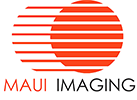See the MAUI Difference
Clinical Use Cases
Dramatically Improved Ultrasound Capabilities
“The ability to provide imaging through and around bone and other impediments to traditional ultrasound provides clinicians with a unique visualization and guidance tool. This provides greater clinical confidence, faster procedures, limits exposure to ionizing radiation, reduces complications, improves clinical outcomes and reduces overall interventional procedure costs. Furthermore, diagnosis and management of patients with different pathologies that would otherwise require x-ray, CT or MRI may be possible in resource-limited contexts.”
– Dr. John Cheronis, M.D., Ph.D.
Trauma Medicine

Clinical Use Case
Cranial Imaging
Traditional ultrasound is limited due to it’s inability to see through and around obstacles such as bone, air, and metal. This video demonstrates the K3900 successfully imaging through the skull and into the cranial vault, showing it’s unique ability to overcome traditional limitations.
This work is being supported by Office of the Assistant Secretary of Defense for Health Affairs through the Combat Casualty Care Research Program under Award No. HT9425-23-3-0002.
This work is being supported by Office of the Assistant Secretary of Defense for Health Affairs through the Combat Casualty Care Research Program under Award No. HT9425-23-3-0002.
Clinical Use Case
Carina Imaging Through Sternum
Traditional ultrasound is unable to see past the sternum, limiting its use in airway diagnosis and procedures. As evidenced in this video, MAUI has the capability of imaging below the sternum, enabling bedside utilization for timely procedures.
Providers spend $9.7B annually on traditional ultrasound systems1 with limited imaging capabilities — while one-half to two-thirds of the global population has no access to medical imaging of any kind.2
Improved ultrasound systems with the ability to image through and around barriers would disrupt the traditional ultrasound market and potentially provide an imaging solution in settings worldwide where big iron can’t go.
Interventional Radiology
Improved ultrasound imaging capabilities will reduce the need for CT and MRI guidance for biopsies and complex interventions, increasing access to procedures where those more expensive modalities are not available, and freeing up the scanners for more efficient utilization where they are available.


Real-time guidance during interventional procedures from live imaging.
Increased availability of CT machines for hospitals and health systems to utilize for high-value procedures.
Reduced procedure time from 60 minutes to 30 minutes enabling a more streamlined workflow for physicians.
Eliminating, or significantly reducing, the patient and care team’s exposure to radiation.
Clinical Use Case
Liver Biopsy
“Currently, biopsies and ablations are performed utilizing both ultrasound and CT imaging. Traditional ultrasound alone isn’t as effective as MAUI CET because it can’t see through and around bone or adipose tissue nor can the instruments used to perform the biopsy or ablation be visualized clearly. This video shows how MAUI CET enables clear visualization of the biopsy needle, eliminating the need for CT.”
– George Khoury, MD
Differentiated ultrasound that can see through and around barriers would facilitate timely diagnosis of traumatic injuries in environments where big iron isn’t accessible.
Military personnel injured in combat zones or onboard naval vessels that currently require medical transport to access CT and MRI.
Remote rural communities lacking diagnostic equipment and situated hours away from the nearest trauma center.
Under-resourced developing countries facing a scarcity of medical personnel and lacking access to medical imaging technologies.
Emergency services and disaster response teams with no portable imaging systems capable of aiding in diagnostics of acute injury.
